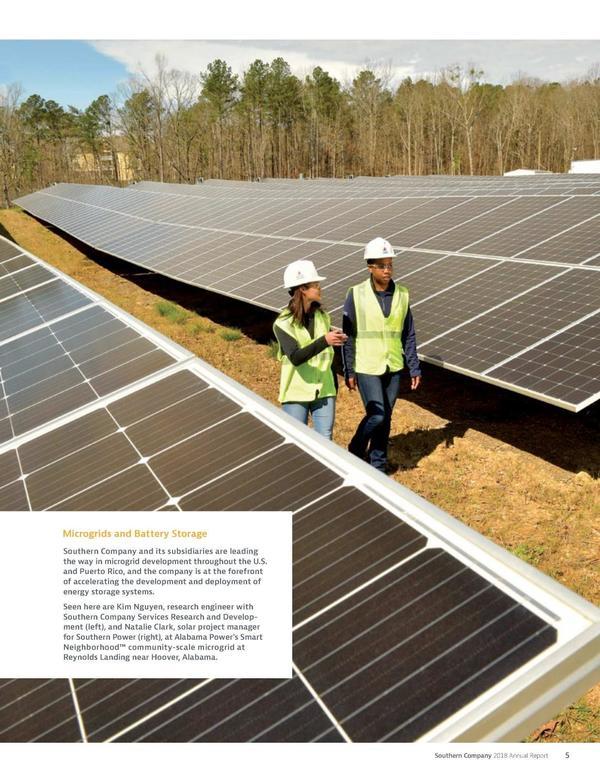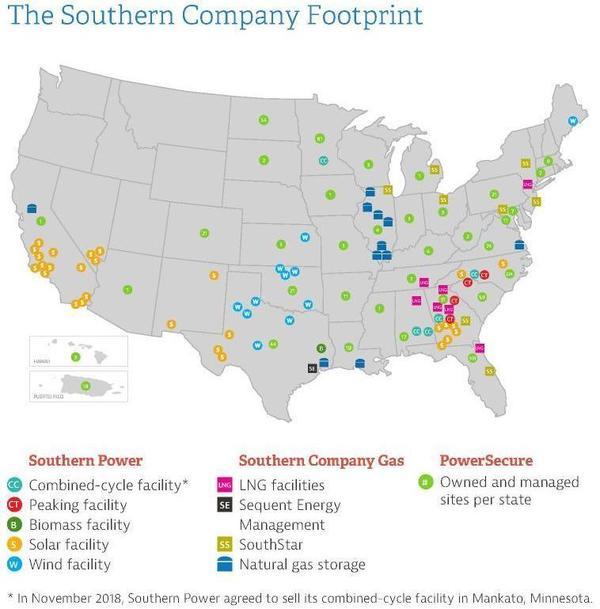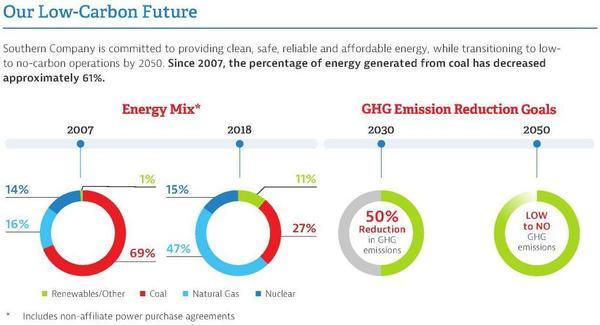In this year’s pilgrimage to Pine Mountain, we will hear how part of Southern Company CEO Tom Fanning’s compensation will be tied to meeting the company’s low-carbon goals.
When: 10AM, Wednesday, May 22, 2019
Where:
The Lodge Conference Center at Callaway Gardens,
4500 Southern Pine Drive, Pine Mountain, Georgia 31822
What: Southern Company 2019 Annual Meeting of Stockholders
That Annual Report page on Microgrids and Batteries looks good. Until you start to notice what’s missing from the documents.
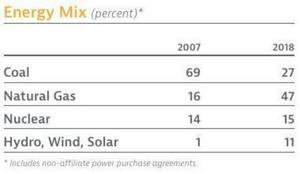 So does this comparison of energy mixes in 2007 and 2018,
at least as far as “Hydro, Wind, Solar” going from 1 to 11%.
However, quite lacking is
any report of major solar power increases in 2018.
So does this comparison of energy mixes in 2007 and 2018,
at least as far as “Hydro, Wind, Solar” going from 1 to 11%.
However, quite lacking is
any report of major solar power increases in 2018.
While coal dropping to less than half its former percentage is indeed good, replacing it mostly by ramping up natural gas from 56 to 47% is yet another bad Big Bet.
Pivotal JAX LNG
Speaking of omissions, what’s that LNG facility in Jacksonville, Florida, on the map at the end of the Proxy Statement?
Over in the Annual Report on page 147 we find:
Pivotal JAX LNG, LLC
Southern Company Gas owns a 50% interest in a LNG liquefaction and storage facility in Jacksonville, Florida, which was placed in service in October 2018. This facility is outfitted with a 2.0 million gallon storage tank with the capacity to produce in excess of 120,000 gallons of LNG per day.
Curiously, there’s no mention of JAX LNG’s dock with a pipeline for its LNG barge, nor of JAX LNG’s half-parent Pivotal LNG, owned by Southern Company, with its contract with Crowley Maritime to ship LNG as far as Puerto Rico for purchase by a pharmaceutical company. All of this is announced on JAX LNG’s own newsroom web page, but not anywhere in Southern Company’s Stockholder Meeting documents. For that matter, Pivotal LNG’s other LNG facilities are plainly visible on the map (3 in Georgia, and one each in Tennessee and Alabama), but are not identified in the documents.
Low-Carbon Future and CEO Compensation
Well, this sounds good: about 61% reduction in coal since 2007, and a goal of 50% reduction in greenhouse gases by 2030 and low to no GHG by 2050.
But since 2007, SO almost tripled the mix percentage of natural gas. And the total of natural gas and coal only went down from 85 to 74%. That difference of 11% is about the same as the mix increase of 10% for “Renewables/Other” which in the previous figure we saw as “Hydro, Wind, Solar”. It’s safe to say Southern Company hasn’t built a bunch of new water power reservoirs or we would have heard about that, so the renewable mix increase has been due to wind and solar power.
It certainly wasn’t due to the never-completed nukes at Plant Vogtle, which only continue work because the GA-PSC hasn’t yet done what Mississippi PSC did and say no more overruns charged to customers. And even SO isn’t going to be building any additional nukes.
So the only way Southern Company can get a 50% reduction in GHG emissions by 2030 is by switching still more coal and a lot of natural gas mix over to solar and wind power.
Which means Southern Company’s own “Low-Carbon Future” plan makes its recent expenditures on natural gas pipelines and power plants and LNG stranded investments.
For that matter, 50% reduction from when? And of which GHG emissions? I hope SO is not counting only CO2 from coal while leaking CH4 (methane) from pipelines and burning it to produce CO2.
Finally, note the fudging of the 2050 goal: “LOW to NO GHG emissions”. Oh, so SO doesn’t really mean no, just some undefined “LOW”.
Nonetheless, an interesting development on page 48 of the Proxy Statement is “New GHG Reduction Metric for CEO’s 2019 Long-Term Incentive Award”
Our energy strategy includes the continued development of a diverse portfolio of energy resources to reliably and affordably serve customers and communities with a focus on reducing GHG emissions, including a 2030 goal of reducing carbon emissions by 50% as compared to 2007 and a goal of low- to no-carbon emissions by 2050.
To demonstrate our commitment to the GHG reduction goals, the Compensation Committee added a new metric to the CEO’s 2019 long-term equity incentive award. A meaningful portion of the CEO’s 2019 PSP award (10% or up to $2 million) is aligned with our GHG reduction goals.
The Compensation Committee worked closely with the Operations, Environmental and Safety Committee to design the new metric. The Committees shared a desire to implement a measurable, quantitative component that is aligned with our 2030 goal of 50% reduction in GHG emissions, as well as a qualitative component that incentivizes behaviors to get us to our goal of low- to no-carbon emissions by 2050.
That section continues with the specific quantative metrics, which make sense, but only insofar as SO’s low-carbon goals make sense.
In the light of SO’s pipeline and LNG buying spree, somebody explain how SO’s low-carbon goals match its actual corporate behavior?
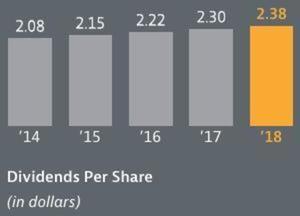 Many stockholders are attracted to Southern Company stock by
its ever-increasing dividends.
Each year, Southern Company ramps up the dividend another notch.
How long can SO contiue doing that, while wasting money
on natural gas stranded investments?
Many stockholders are attracted to Southern Company stock by
its ever-increasing dividends.
Each year, Southern Company ramps up the dividend another notch.
How long can SO contiue doing that, while wasting money
on natural gas stranded investments?
Only a few years ago, SO made Georgia jump to the top of fastest-growing solar states, for a several reasons discussed in this blog before. That’s the main reason why SO went from 1% renewable energy in 2007 to 11% in 2018. That’s an increase of 110 times. No other power source grows like that, except wind power, and wind isn’t even as fast as solar. Then SO took its foot off the accellerator, with few if any solar purchases in the past year, and only a few of wind.
Instead, SO shoveled more dollars into the natural gas pipeline money pit.
Including into buying AGL Resources, parent of Pivotal LNG with its JAX LNG. And AGL owns the pipeline that goes to Homerville, Georgia, where its gas in September 2018 resulted in an explosion that blew up a coffee shop and sent three women to hospital with third-degree burns. Georgia PSC staff propose to fine AGL more than $2 million for that incident. PSC Staff also allege at least one statement AGL reported to the Pipeline & Hazardous Materials Safety Administration (PHMSA) had “no basis in fact”.
Such pipelines seem like bigger risks to future dividends than solar panels, which do not leak or explode.
-jsq
Investigative reporting costs money, for open records requests, copying, web hosting, gasoline, and cameras, and with sufficient funds we can pay students to do further research. You can donate to LAKE today!
Short Link:
